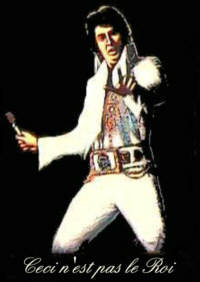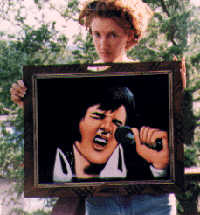| The Siderealist movement burst upon the art
scene like an inflamed appendix, causing much pain, the
point of which remained obscure. Guillaume Voiture du
Marchandises was one of the movement's primary
visionaries and proselytizers in the early years,
creating many of the hallmarks of the Siderealist
approach: issuing strident manifestoes denouncing limes
as "snobbish" while praising lemons as
"proud", refusing to allow his works to be
shown if Mercury was retrograde and publishing his
autobiography, Le Supplice et les Pois Chiche, at
the age of 19, before any of his works had been exhibited
and while he was still living at home, eating his
mother's vegan cuisine. |

Ceci n'est pas le Roi,
date unknown, oil on black velvet, by Guillaume Voiture
du Marchandises (Fr., 18??-19??) |
| His masterwork, Ceci n'est pas un clown,
was perhaps the defining moment of the Siderealist
movement, yet it also marked the beginning of a split
between Du Machandises and the movement. The picture
caused a stir in the Art community in general, but the
effect on the Siderealists was catastrophic. At its
unveiling, the Siderealist chanteuse and
"hallucinant" tambouriniste Patrice
l'Eaux cried out, "C'est triste! Plus triste!"
and ran out of the hall, not to be seen until a full two
weeks later when she debuted the song that would become
the Siderealist anthem, Quand Jai Vu le Clown, Je Crie.
The
Siderealists became obsessed with Sad Clowns to the
exclusion of nearly all else, but Du Marchandises had
moved on to other ideas. Ceci n'est pas un clown led
directly to Ceci n'est pas le Roi, which had all
the hallmarks of a Siderealist work but was rejected from
their annual Le Citron Noble show on the grounds
that it didn't feature a sad clown, a debatable ruling
for a number of reasons. Angrily, Du Marchandises issued
a statement in which declared that he would never paint a
clown just to please the other Siderealists. "I used
to find them amusing but now they disgust and frighten
me." he wrote, although it's not clear to whom he
was referring.
|
| Du
Marchandises' next move was to stage a number of
exhibitions he called Le Jardin Du Rois, the foci
of which were not the deliberately flat black velvet
portraits but the arrangement of them in an outdoor
setting, each one held by a young woman in an apron
bearing the inscription embrasser le chef.
The
refusal of the Siderealists to even acknowledge the Jardins
led Du Marchandises to formally break all ties with
the movement, which probably saved his life.
|
 An
early color photograph of a Jardin du Rois, probably
staged outside Paris, date unknown. An
early color photograph of a Jardin du Rois, probably
staged outside Paris, date unknown. |

 An
early color photograph of a Jardin du Rois, probably
staged outside Paris, date unknown.
An
early color photograph of a Jardin du Rois, probably
staged outside Paris, date unknown.

